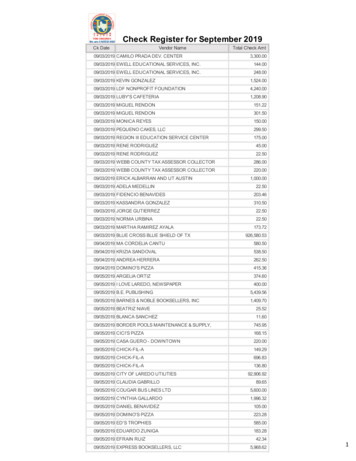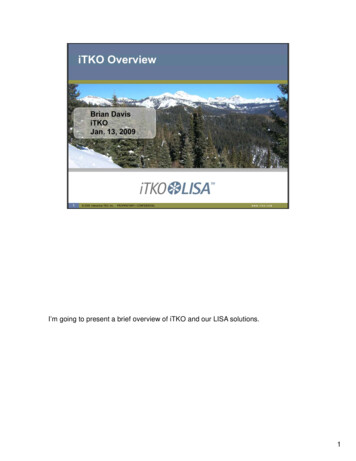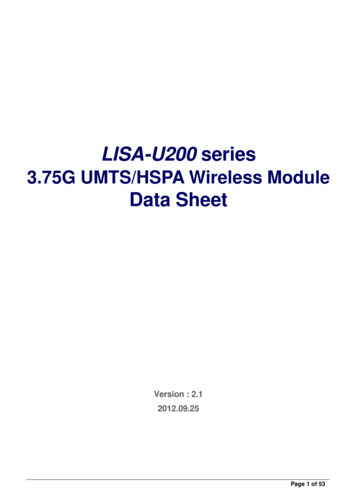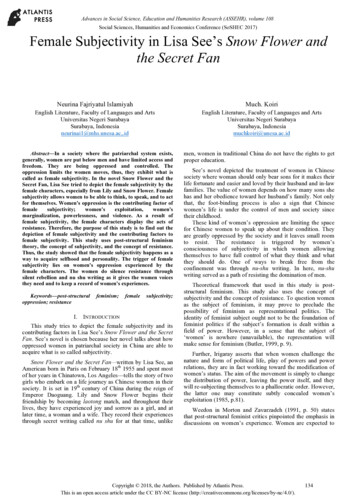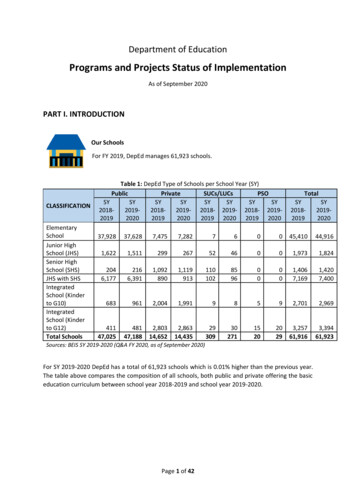
Transcription
22/03/2019Lisa.blueCustomer: Philippe-Auguste ‑ Project reference: Musée du LouvreExecuted by Vincent Juhel Ouaip, on Friday, 22 March 2019.Generated with Lisa.blue software version 18.11.04.Global dataBuilding address: Musée du Louvre, 75001 Paris, FranceAltitude: 34 m Gravity: 9.81 N/kgEurocodes standards :basis : EN 1990 (03/2003) FR NA (12/2011)(Consequences class CC3 High consequence for loss of human life, or economic, social or enviromnentalconsequences very great. )snow loads : EN 1991 1 3 (07/2003) FR NA (05/2007)wind actions : EN 1991 1 4 (2005) FR NA (03/2008)seismic actions : EN 1998 1 (12/2004) FR NA (12/2013)fire actions : EN 1991 1 2 (11/2002) FR NA (02/2007)SnowThe building is located in snow zone A1 at an altitude of 34 m .Snow standardThe standard applicable for snow load calculation on this building is EN 1991 1 3 (07/2003) and its national annex FR NA (05/2007).Characteristic snow load on the groundThe values of surfacic loads of snow on the ground sk,0, corresponding tolower altitudes, are specified by the national annex.This one provides a country map divided into climatic zones.For the zone A1, the specified value of the load is : sk,0 0.450 kN/m2.Characteristic snow load on the ground of the siteThe load sk,34 m incorporates the influence of altitude here equal to0.000 kN/m2 :sk,A (NF EN 1991 1 3 /NA)sk,34 m sk,34 m 0.450 kN/m2Normal snow load on the ground of the siteThe National Annex does not give the elements for adjusting the snow loadon the ground with the return period.So we will just have: sn sk,34 m 0.45 kN/m²Accidental snow load on the ground of the siteThe values of sAd are given by the map attached to this standard. Thesevalues are independent of altitude.sAd 0 kN/m² (NF EN 1991 1 3 /NA Clause 4.3 )Equivalent snow depth on the ground of the siteFor checkings at serviceability limit states:fresh snow depth 45 cm,settled snow depth 22 cm,old snow depth 12 cm,wet snow depth 11 cm.with: snow depth For checkings at ultimate limit states:fresh snow depth 67 cm,settled snow depth 33 cm,old snow depth 19 cm,wet snow depth 16 cm.with: snow depth with: (Annex E)fresh snow density 1 kN/m3,settled snow density 2 kN/m3,old snow density 3.5 kN/m3,wet snow density 4 bd3625/report/assumptions1/7
22/03/2019Lisa.blueThe building is located in wind zone 2.Wind standardThe standard applicable for wind load calculation on this building is EN 1991 1 4 (2005) and its national annex FR NA (03/2008).Fundamental values of the basic wind velocityThe fundamental value of the basic wind velocity, vb0, is the characteristic10 minutes mean wind velocity, irrespective of wind direction and time ofyear, at 10 m above ground level in terrain of 'open country' type.The fundamental values of the basic wind velocity are specified by theNational Annex.This one provides a country map divided into climatic zones.For the zone 2, the specified value of the velocity is: vb0 24 m/s .Basic wind velocity vb on the building site during a period of 100 yearsProbability coefficient of exceedingThe probability p of exceedance is considered on the useful life of theproject, itself based on the use of the project.The design working lives are given in the NF EN 1990 /NA Tableau2.1(NF) depending on the use.For our building project, the use is "ERP", the recommended duration ofuse, necessary for determining the return period, is therefore 100 years.The 10 minutes mean wind velocity having the probability p for an annualexceedence is determined by multiplying the basic wind velocity vb by theprobability factor of severe wind cprob:cprob (NF EN 1991 1 4 Equation 4.2)cprob cprob 1.0325Directional factor of wind'wind direction' means the direction from which the wind comes.By convention, this direction is indicated by the angle it forms with the North, increasing from 0 to 360 in the direction ofclockwise.High velocities of wind are observed more frequently in some sectors directions; the directional factor allows a reduction when thewind comes from a direction where the probability of occurrence of severe winds is lesser.The envisaged reduction should be permitted in all the nominal wind sector considered to be validly adopted.The impact of this reduction is important because the coefficient cdir is taken into account when calculating the velocity and thatthe wind pressure is evaluated from the square of this velocity.The values of the directional factor of wind cdir, zone 1 for different wind directions are indicated in the NF EN 1991 1 4 Figure4.4(NA).Season factorThe value of the season factor cseason is given in the NF EN 1991 1 4 Figure 4.5(NA).It is considered here that the project duration is longer than 1 year and does not allow for seasonal decrease in the risk of strongwinds, therefore cseason 1.The basic wind velocity vb on the building site, defined for each direction of the wind at 10 m above ground level in terrain of 'opencountry' type falling into the terrain category II, is shown in the graph 625/report/assumptions2/7
22/03/2019Lisa.bluewith:(EN 1991 1 4 Equation 4.1)OrographyThe altitudes are arbitrarily identified at 150m, 500m and 1000m around the construction.A 3D interpolation of these points allows to evaluate the shape of the terrain in the vicinity of the construction shown in the graphbelow:Peak velocity pressure qpFor each surfaces of the building, wind effects are observed in 4 nominal angular sectors of 90 :the highest basic wind velocity vb contained in each of its sectors is retainedthis velocity is amplified by the orography factor co taking into account the relief of the terrain.it is then adjusted taking account of the impact of terrain roughness on the variability of the mean wind velocity.the peak velocity pressure qp is finally calculated with taking account of the density of air and the rapid fluctuations invelocity.Niveau 1Wind from 25 :Effect from orographyOrographic profile Flat landThe effects of orography may be neglected when the mean slope of the upwind terrain is less than 5%. (EN 1991 1 4 §4.3.3(2))Here, the upwind terrain slope is 0 % : co 1Effect from terrain roughness:Terrain category IV (National annex to EN 1991 1 4 §4.3.2(1))Urban areas with at least 15% of the surface is covered with buildings whose average height is greater than 15 m; foreststerrain factor:kr (EN 1991 1 4 equation 4.5)kr kr 0.2343height above ground level or the minimum height depending on the terrain category:z 20.000 mroughness factor:cr(z) (EN 1991 1 4 equation 4.4)cr(z) cr(z) 0.702Peak velocity pressure:qp(z) qp(z) qp(z) 0.555 kN/m²with:mean wind velocity:vm(z) vm(z) vm(z) 17.395 m/s(NF EN 1991 1 4 equation 4.8)(NF EN 1991 1 4 equation 5/report/assumptions3/7
22/03/2019Lisa.blueair density:ρ 1.225kg/m3 (NF EN 1991 1 4 clause 4.5(1) NOTE 2)turbulence factor:kl (NF EN 1991 1 4 equation 4.20 NA)kl kl 0.854turbulence intensity:iv (NF EN 1991 1 4 equation 4.7)iv iv 0.285Wind from 115 :Effect from orographyOrographic profile Flat landThe effects of orography may be neglected when the mean slope of the upwind terrain is less than 5%. (EN 1991 1 4 §4.3.3(2))Here, the upwind terrain slope is 0 % : co 1Effect from terrain roughness:Terrain category II (National annex to EN 1991 1 4 §4.3.2(1))Open field, with or without a few isolated obstacles (trees, buildings, etc.) separated from each other by more than theirheight x40terrain factor:kr (EN 1991 1 4 equation 4.5)kr kr 0.1900height above ground level or the minimum height depending on the terrain category:z 20.000 mroughness factor:cr(z) (EN 1991 1 4 equation 4.4)cr(z) cr(z) 1.138Peak velocity pressure:qp(z) qp(z) qp(z) 1.054 kN/m²with:(NF EN 1991 1 4 equation 4.8)mean wind velocity:vm(z) (NF EN 1991 1 4 equation 4.3)vm(z) vm(z) 28.209 m/sair density:ρ 1.225kg/m3 (NF EN 1991 1 4 clause 4.5(1) NOTE 2)turbulence factor:kl (NF EN 1991 1 4 equation 4.20 NA)kl kl 0.995turbulence intensity:iv (NF EN 1991 1 4 equation 4.7)iv iv 0.166Wind from 205 :Effect from bd3625/report/assumptions4/7
22/03/2019Lisa.blueOrographic profile Flat landThe effects of orography may be neglected when the mean slope of the upwind terrain is less than 5%. (EN 1991 1 4 §4.3.3(2))Here, the upwind terrain slope is 0 % : co 1Effect from terrain roughness:Terrain category II (National annex to EN 1991 1 4 §4.3.2(1))Open field, with or without a few isolated obstacles (trees, buildings, etc.) separated from each other by more than theirheight x40terrain factor:kr (EN 1991 1 4 equation 4.5)kr kr 0.1900height above ground level or the minimum height depending on the terrain category:z 20.000 mroughness factor:cr(z) (EN 1991 1 4 equation 4.4)cr(z) cr(z) 1.138Peak velocity pressure:qp(z) qp(z) qp(z) 1.054 kN/m²with:(NF EN 1991 1 4 equation 4.8)mean wind velocity:vm(z) (NF EN 1991 1 4 equation 4.3)vm(z) vm(z) 28.209 m/sair density:ρ 1.225kg/m3 (NF EN 1991 1 4 clause 4.5(1) NOTE 2)turbulence factor:kl (NF EN 1991 1 4 equation 4.20 NA)kl kl 0.995turbulence intensity:iv (NF EN 1991 1 4 equation 4.7)iv iv 0.166Wind from 295 :Effect from orographyOrographic profile Flat landThe effects of orography may be neglected when the mean slope of the upwind terrain is less than 5%. (EN 1991 1 4 §4.3.3(2))Here, the upwind terrain slope is 0 % : co 1Effect from terrain roughness:Terrain category II (National annex to EN 1991 1 4 §4.3.2(1))Open field, with or without a few isolated obstacles (trees, buildings, etc.) separated from each other by more than theirheight x40terrain factor:kr (EN 1991 1 4 equation 4.5)kr kr 0.1900height above ground level or the minimum height depending on the terrain category:z 20.000 mroughness factor:cr(z) (EN 1991 1 4 equation 5/report/assumptions5/7
22/03/2019Lisa.bluecr(z) cr(z) 1.138Peak velocity pressure:qp(z) qp(z) qp(z) 1.054 kN/m²with:(NF EN 1991 1 4 equation 4.8)mean wind velocity:vm(z) (NF EN 1991 1 4 equation 4.3)vm(z) vm(z) 28.209 m/sair density:ρ 1.225kg/m3 (NF EN 1991 1 4 clause 4.5(1) NOTE 2)turbulence factor:kl (NF EN 1991 1 4 equation 4.20 NA)kl kl 0.995turbulence intensity:iv (NF EN 1991 1 4 equation 4.7)iv iv 0.166The peak velocity pressures qp, applied on the surface Niveau 1 at a level of 20m, are drawn on this graph for each sector ofwind:Maximum equivalent peak wind velocity (at the ridge Lvl 20.0m)149 km/h to control the vibrations and the deformations of the structure at serviceability limit states (SLS).v 149 km/h183 km/h to control the resistance of the structure at ultimate limit state (ULS).v 183 km/hSeismSeism standardThe standard EN 1998 1 (12/2004) and its national annex FR NA (12/2013) define the design rules and design methods for seismic actions onbuildings.Legislative texts about seismZoning: Art. D563 8 1, Décret N 2010 1255 (22/10/2010)The construction is located at Paris in a very low seismicity zone (zone 1).Classification: Art. 2, Arrêté du 22/10/2010 modifié par Art.1, Arrêté du 15/09/2014Reference peak ground accelerationThe intensity of the acceleration agr is function of the seismic zone. Its value of 0.4 m/s² is specified in Art. 4, Arrêté du22/10/2010 modifié par Art.1, Arrêté du 15/09/2014.Use for importance classification:The building's use is of type "establishment open to the public of 1st category" (Public establishment classification according toArticle R*123 19 du code de la construction et de l'habitation )According to Art. 2, Arrêté du 22/10/2010 modifié par Art.1, Arrêté du 15/09/2014, the importance category associated to seism isIII.Importance factor of the buildingThe factor ƔI is function of the importance category of the building. Its value of 1.2 is specified in Art. 2 §III, Arrêté du22/10/2010 modified by Art.1, Arrêté du 15/09/2014.Paraseismic checkingA building located in seismic zone 1 does not require the application of Eurocode 8.FireLegislative texts about 25/report/assumptions6/7
22/03/2019Lisa.blueThe reference document, Arrêté du 25 juin 1980 , indicate the security arrangements against the risk of fire, including fire resistancedurations structures.Fire standardThe standard EN 1991 1 2 (11/2002) and its national annex FR NA (02/2007) define the design rules and design methods for fire actions tobuildings.Use for fire classificationestablishment open to the public of 1st category with the bottom floor of the last level accessible to the public less than 8 metersabove the ground(Public establishment classification according to Article R*123 19 du code de la construction et de l'habitation )Fire resistance of structuresRequired fire resistanceVertical support: 60 minutesFloors: 60 minutesRoof: 60 minutes Copyright 2015-2019 — Lisa.blue version 18.11.04 — d2f504fabd3625/report/assumptions7/7
22/03/2019 Lisa.blue port/assumptions 2/ 7 5IF CVJMEJOH JT MPDBUFE JO XJOE [POF 8JOE TUBOEBSE





